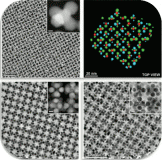Fabrication of porous materials with novel crystal structures assembled from nanoparticles
A research team involving CIC biomaGUNE researchers has devised a method for the fabrication of porous materials – technically referred to as macroporous or mesoporous materials – with hitherto unseen crystal structures.
The work, published in the prestigious journal Science, reveals the potential to further expand the family of nanostructured materials and lays the ground for the discovery of highly interesting properties. As Luis Liz-Marzán, Scientific Director and Ikerbasque Research professor at CIC biomaGUNE, explains: “These crystal structures are not made of atoms but of nanoparticles; in other words, they are nanostructured crystals, also referred to as supercrystals or supracrystals”.
To explain and highlight the scientific dimension of the findings of the research, Dr. Liz-Marzán adds: “The most singular characteristic of the structures obtained is that they exhibit relatively large and perfectly ordered gaps. This is very difficult to obtain using currently existing methods. The key to fabricating these materials lies in using mixtures of two types of nanoparticles – gold and iron oxide in this case – to form binary crystals. Subsequently, one of the components can be selectively removed and gaps left in its place. A wide variety of structures with brand new properties can be obtained by varying the sizes of the two components”.
Initially, the new materials have been applied in the technique referred to as SERS (Surface Enhanced Raman Scattering). The gaps between nanoparticles generate electric fields which enable the detection of very few molecules. Applications in other fields such as metamaterials (through new structures made of nanoparticles) and catalysis (a process favoured by the presence of a very large surface area for catalytic reactions to take place) are likely.

